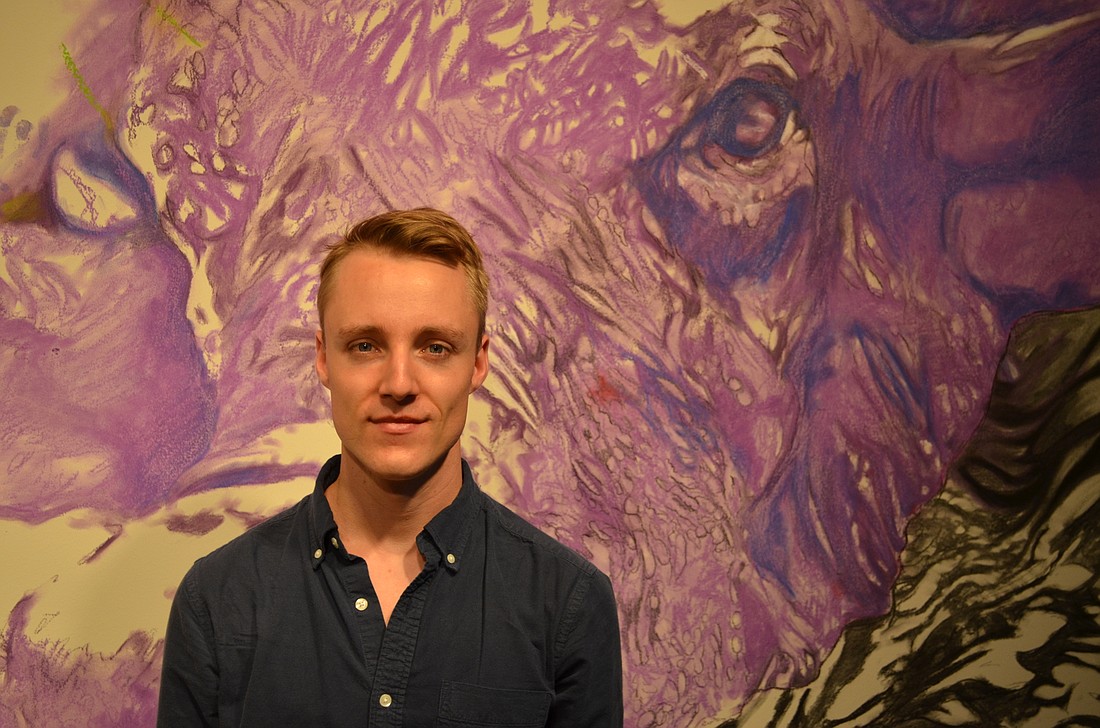- April 18, 2024
-
-
Loading

Loading

Last season, the Richard and Barbara Basch Gallery in the heart of the Ringling College of Art Design was home to the typical fare of high visual art. There was dozens of priceless pieces of Italian glass art. There were various shows featuring abstract art emblazoned on canvases large and small and hung and lit with care on the walls. But to start off the Ringling College’s first series of shows this season, there won’t be any canvases or frames on each artist’s respective wall. For this show, the wall is the canvas.
“Four Artists/ Four Walls” which opened on August 21 and runs through Sept. 22, features massive installations by four local artists: Dustin Juengel, Patrick Lindhardt, Nathan Skiles and Steven Strenk. Each artist selected one of the four different walls inside the Basch Gallery. Then the artists had roughly one week to draw, paint and create right on the gallery walls.
“It’s something I’ve been wanting to do for the last seven years,” says Mark Ormond, curator of exhibitions at Ringling College, who organized the show. “I’ve been increasingly watching the student work get smaller and smaller. One of the things that excites the students is to see large-scale work. I wanted to challenge four faculty members to make large-scale drawings and actually use the wall as the ground of the drawing.”
And like four boxers going into their respective corners, the four artists spent hours at a time developing their overall work of art. Each artist had 24-hour access to the gallery space and some would burn late into the night on their respective project. One were colorful and stylized portraits. One was something out of a mad scientists diary. Another was an optical illusion sneak peek into an artists studio. And the last was an optical illusion that literally tore open the walls.
“I don’t think I’ve ever drawn right on the wall before,” says Juengel, participating artist and exhibition curator at the Art Center Sarasota. “I had used large canvas before but this definitely is the largest piece I’ve done before.”
Juengel’s wall, located on the left side of the gallery as you enter, is dominated by three colorful and giant portraits of three seemingly random subjects. On the left is the head of a bearded and imposing man that looks like an Olympic deity from Greek or Roman antiquity. In the middle is a shirtless soldier hoisting a piece of statue, and then on the right a purple cow.
“The pieces slowly evolved,” says Juengel. “I didn’t know what materials I was going to use for the project so I got four different chalk colors and purple was one of them. I liked how the purple and the orange collected with the space and I thought that I needed way more orange to make that purple pop.”
Adjacent to Juengel’s bright orange and purple creations and moat of chalk shavings and dust lying on the floor is Steve Strenk’s own chalk creation, but this one the polar opposite of Juengel’s expressive still life portraits.
Drenched in that familiar hue of professional, blueprint blue, Steven Strenk’s wall is a master plan of some fictional yet seemingly functional Rube Goldberg device. Unlike Juengel’s expressive portraits, Strenk’s use of white chalk on the wall is completely utilitarian and functional.
“A lot of my work in kinetic sculpture, drawing and paint, I’m inspired by mechanisms,” says Strenk. “I thought I would do a giant blueprint that someone put on the wall.” Like his three fellow artists, Strenk first had access starting on Saturday, August 14 and had less than a week to complete their wall design for Ringling College’s first art walk of the semester that Friday. Strenk dived into his wall by covering it in blue paint and then with project screen his already drawn design featuring bolts, nuts and conveyer belts onto the wall. From there Strenk, armed only with a chalk reel, a giant, old-school wooden compass and a ladder, Strenk began laying down his plans with the help from his fellow wall artists.
“What I really enjoyed about this whole process was the mixing back and forth of different conversations,” says Strenk. “There’s this huge conversation that you normally wouldn’t have because the artists are very solo. It’s nice coming together and working in a shared space. A whole different conversation happens.”
And perhaps the most remarkable aspect of this show – four artists in the same space, using the walls as a canvas, sidewalk chalk, etc. – was that after September 22, the artists’ work will be erased from existence as the gallery managers paint over it to make way for the next show. But as they put the final touches on before the opening night reception, the artists have no regrets for their art having an expiration date. It’s the impact the art has on visitors that truly lasts.
“The artists aren’t always going to be present when the visitor comes to the gallery,” says Ormond, “but because of the energy that they’ve invested in the wall, and because the wall is part of the building, there’s a kind of energy in the space that I don’t think you necessarily have when you’re hanging a framed painting on a wall.”